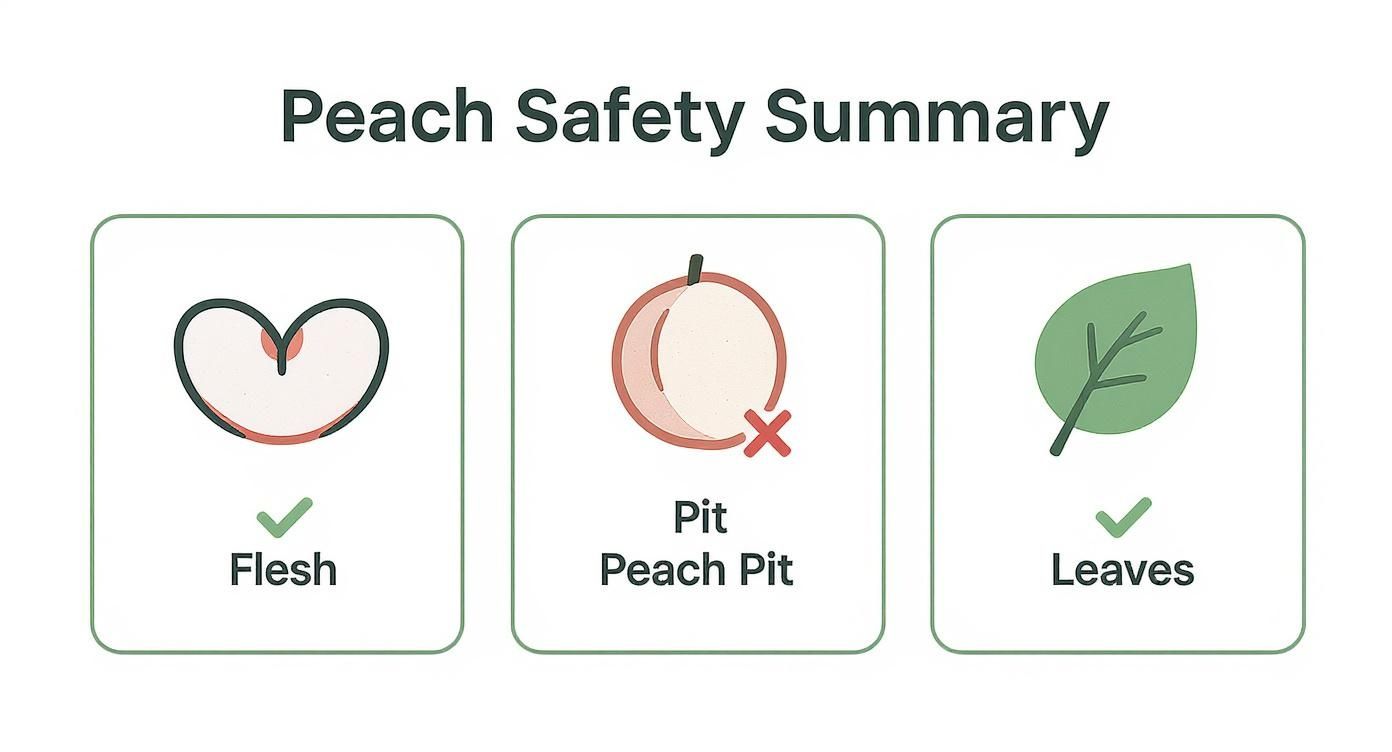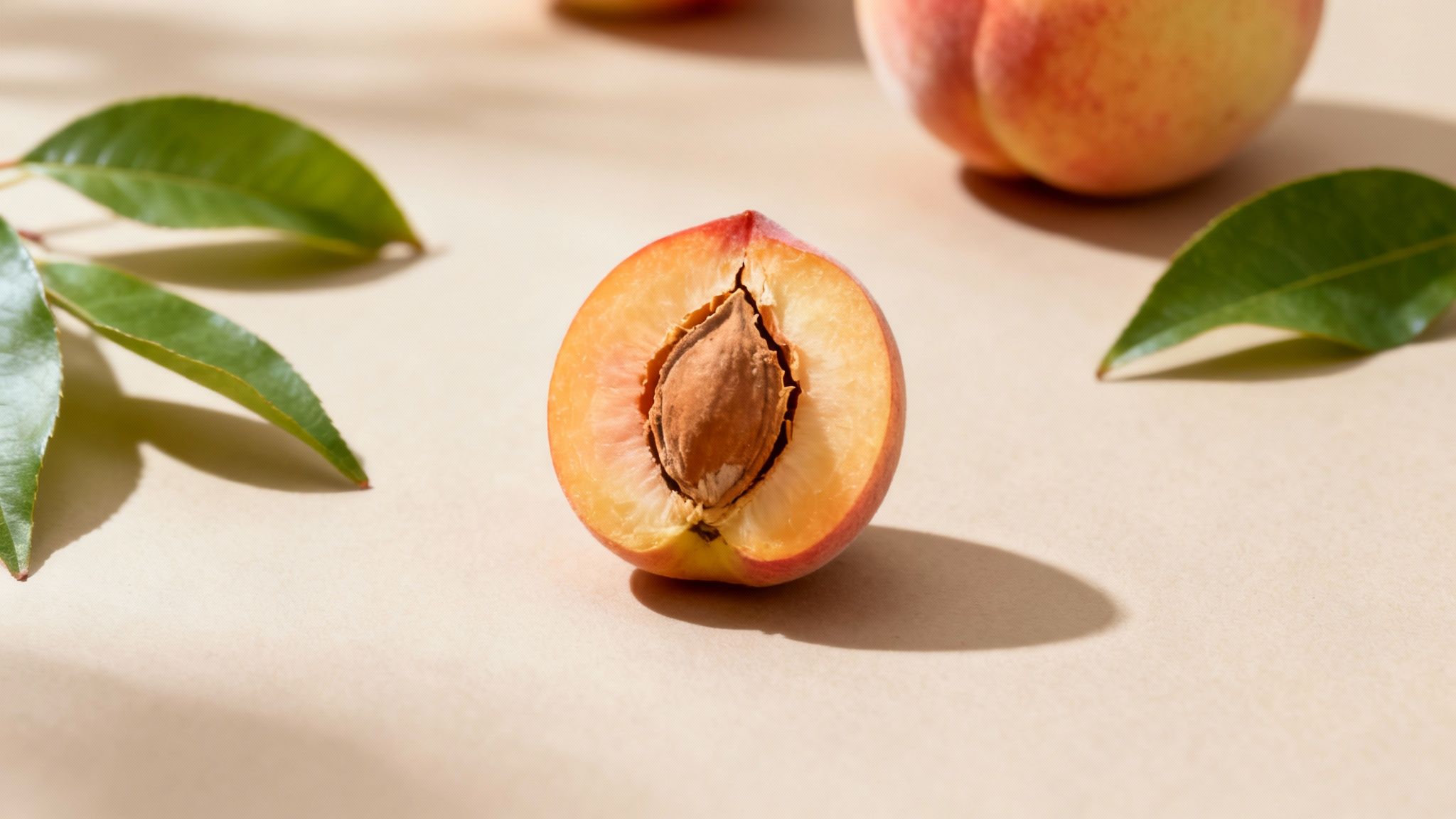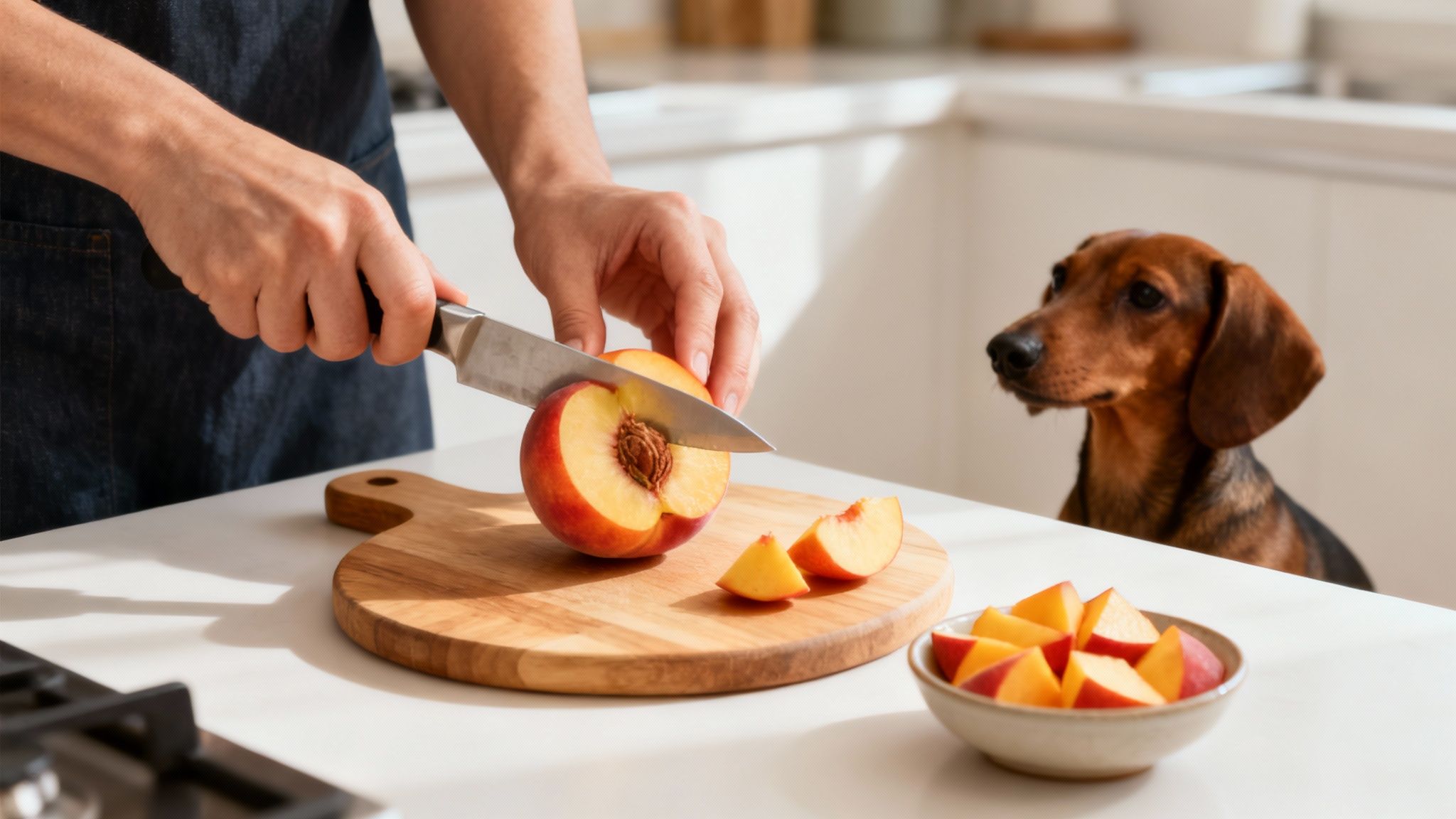Yes, you can absolutely share peaches with your dog, but there's a really important catch we need to talk about. It's all about how you prepare them. While the juicy, sweet flesh is a perfectly safe and delicious treat for your furry best friend, the pit, stem, and leaves are a definite no-go. You need to remove them completely before you share this lovely fruit.
Your Guide to Safely Sharing Peaches
Seeing that happy, tail-wagging face when you offer a tasty snack is one of the real joys of being a dog parent, isn't it? We completely get it. You want to share a bit of what you're enjoying, but you also need that peace of mind, knowing it's absolutely safe for them.
When it comes to peaches, you can breathe a sigh of relief, as long as you follow a few simple rules.
The main worry isn't the soft, fleshy part of the fruit that we all love. The real danger is hidden inside and on the plant itself. A good way to think of it is this: the fruit is the treat, but the pit is a hidden hazard that we need to dispose of carefully.
To keep things wonderfully simple, let's break down which bits of a peach are a friend and which are a foe for your beloved dog.
This image sums it up perfectly: only the soft flesh of the peach is okay for your dog. Both the pit and the leaves pose serious risks, and we'll chat more about those in just a moment. Proper preparation truly is everything.
To give you a quick reference, here’s a simple checklist to keep in your mind.
Peach Safety Checklist for Your Dog
| Part of the Peach | Is It Safe for Dogs? | Key Reason Why |
|---|---|---|
| Flesh | Yes | Nutritious and tasty in moderation. |
| Pit / Stone | No | Choking/blockage risk and contains cyanide. |
| Skin | Yes, but… | Edible but can be tough to digest. Best in small bits. |
| Stem | No | Contains toxic compounds and is a choking hazard. |
| Leaves | No | Also contains toxic compounds harmful to dogs. |
So, as long as you stick to serving just the prepared flesh, you can turn what could be a risky situation into a lovely bonding moment with your furry best mate.
The Surprising Health Benefits of Peaches
Now that we've established that peaches are safe when prepared with care, let's get to the good stuff. Why would you want to share a slice with your furry companion in the first place? Well, beyond the obvious tail-wagging joy a juicy treat brings, peaches are packed with goodness that can genuinely support your dog’s health.
When you offer a few bits of fresh peach, you’re not just giving them a sweet snack. You're sharing a source of important nutrients that play a real role in their daily well-being, making it a treat you can feel truly good about giving.
A Boost for Their Body
One of the standout perks of peaches is their vitamin content. They're a great source of both Vitamin A and Vitamin C, two powerful nutrients that are fantastic for your four-legged friend.
- Vitamin A: This is essential for keeping their vision sharp, especially as your dog gets a little older. It also plays a key part in maintaining healthy skin and a shiny, full-looking coat.
- Vitamin C: Think of this as a brilliant little supporter for their immune system. It acts as an antioxidant, helping to protect your dog’s body from damage and keeping their natural defences strong and resilient.
On top of that, peaches are a good source of dietary fibre. Just like with us, fibre helps keep your dog's digestive system moving along smoothly. This is a big plus for promoting regular, healthy toilet habits, and a happy gut often means a very happy dog!
Peaches offer vitamins, fibre, and antioxidants, which can benefit dogs when given in moderation. However, their high sugar content means they must be managed correctly to avoid issues like obesity.
Here in the UK, it’s quite common for us to top up our dog’s main meals with healthy treats. While no one is tracking how many peaches our pups are eating, we do know that around 41% of UK dogs eat wet foods, which are often complemented by snacks like fruit. The key is always balance, ensuring peaches are an occasional delight rather than a daily staple. You can find out more about the national perspective on dogs eating peaches from Rover.
Understanding the Real Dangers of Peaches
Your dog's safety is everything, so let's have an honest chat about the risks that come with peaches. While the juicy flesh is a lovely treat, other parts of the fruit are genuinely dangerous, and it’s so important that we understand why. Our goal here is to give you the knowledge you need, so you can feel completely confident and avoid any accidents.
The number one hazard we need to talk about is the peach pit, also known as the stone. It’s a triple threat to your furry friend.
Firstly, its size and shape make it a serious choking hazard, especially for smaller dogs or those who tend to gulp their food. If swallowed whole, it can also lead to a life-threatening intestinal blockage, which often requires emergency surgery. It’s a scary thought, we know.
But the hidden danger inside the pit is the most serious. Peach pits, along with the plant's stem and leaves, contain a cyanide compound called amygdalin. If your dog chews or breaks the pit, this toxin can be released, which is incredibly dangerous.
Beyond the Pit and Stem
Even after you've safely removed the pit, stem, and any leaves, there’s another factor we need to consider: the sugar. Peaches have a high natural sugar content. While it's not toxic like the pit, too much sugar can cause problems for your dog over time.
An occasional slice won't cause harm, but regularly giving your dog sugary fruits can lead to:
- An upset stomach, including diarrhoea.
- Unwanted weight gain, contributing to obesity.
- Dental problems down the line.
The cyanide risk in peach pits is similar to that found in other common plants. For your own peace of mind, it’s a great idea to familiarise yourself with the full list of plants toxic to dogs that may be in your home or garden. By understanding these risks, we can make sure our homes are safe spaces for our four-legged family members, ensuring treat time is always a happy and worry-free experience for everyone.
How to Safely Prepare Peaches for Your Dog
Alright, now that we've covered the good and the bad, let's get to the fun part: sharing this juicy treat with your dog. Getting a peach ready for your pup is wonderfully simple, and we'll walk you through it to make sure it’s a happy, tail-wagging experience for everyone involved.
First thing's first: always grab fresh, ripe peaches. Please give the tinned or syrup-packed ones a wide berth. They're often loaded with added sugars, preservatives, or even artificial sweeteners that can really do a number on your dog's sensitive stomach.
Once you’ve picked the perfect peach, give it a proper wash under the tap. This simple rinse gets rid of any lingering pesticides or dirt from the skin, ensuring your furry mate is only getting the good stuff.
The Most Important Steps
Now for the most critical part of the whole process. Before you even think about handing over a piece, you absolutely must prepare the fruit correctly. Your dog's safety really does depend on these next few actions.
- Remove the Stem and Any Leaves: Gently pull off the stem and double-check for any stray leaves. These bits contain compounds that just aren't safe for your dog to nibble on.
- Cut and Pit the Peach: Slice the peach open and get that hard stone out of the centre. This is completely non-negotiable. The pit is a serious choking hazard and, as we know, it's also toxic.
- Slice into Bite-Sized Pieces: Chop the soft flesh into small, manageable chunks that are right for your dog’s size. A tiny chihuahua is going to need much smaller pieces than a Great Dane, after all!
By following these simple preparation steps—wash, pit, and slice—you completely eliminate the major risks and turn a peach into a perfectly safe and delightful doggy treat.
When you're looking for more safe and enjoyable snacks, it's always a good idea to explore a wider range of approved doggy treats. This way, you'll always have some healthy, vet-approved options ready to go when you want to spoil them.
Serving the Right Amount of Peach
It’s just so easy to get carried away when your dog is staring up at you with those big, hopeful eyes. We’ve all been there! But when it comes to treats like peaches, getting the portion size right is absolutely key to keeping them healthy and happy. Too much of a good thing, even natural fruit, can cause more problems than it solves.
So, how much is just right? Vets and pet nutritionists have a brilliant guideline called the 10% rule. It’s a simple concept: treats, including delicious fruits like peaches, should make up no more than 10% of your dog’s total daily calorie intake. The other 90% should always come from their main, balanced dog food.
Following this rule helps keep their diet on track and prevents any nasty tummy troubles. If your dog already has a history of digestive upset, finding the best dog food for a sensitive stomach is a great first step, and sticking to the 10% rule is the perfect way to support that.
Practical Portion Sizes
To make this rule a bit easier for you to follow, let’s talk specifics. Portion sizes should always be based on your dog's size.
- For small dogs (like a Dachshund or a Terrier): One or two small, thin slices of peach are plenty for a treat.
- For medium to large dogs (like a Labrador or German Shepherd): A few more slices, perhaps up to a quarter of a peach, would be suitable.
Keep in mind, these are just occasional treats, not a daily snack. UK pet nutrition guidelines suggest small dogs should only have about two pieces of peach per week, while larger dogs might tolerate up to five pieces.
Peaches are a summer fruit often enjoyed by people here in the UK. While there isn't specific data on how many dogs are eating peaches, the advice from experts is consistent: serve in moderation and always remove the pit and leaves. To see more on this, you can discover insights about feeding dogs peaches from PetMD.
Common Questions from UK Dog Owners
We know you've got the basics down, but it's completely normal for a few extra questions to pop into your head. As fellow dog lovers, we've heard them all, so let's tackle the most common queries we get from owners just like you across the UK.
This is all about giving you that final bit of confidence, so you can share this lovely fruit without a single worry.
What If My Dog Accidentally Eats a Whole Peach?
First thing's first: try not to panic. We know it's easier said than done. The main worry here isn't the fruity flesh, but whether they managed to swallow the pit.
If you even suspect they’ve gulped it down, it’s vital to ring your vet right away for advice. They'll likely ask you to keep a close eye on your dog for any signs of an intestinal blockage, which can include things like vomiting, seeming really tired and lethargic, or a sudden loss of appetite. The pit is a serious hazard, so getting professional advice is always the safest and best thing you can do.
Are Frozen or Dried Peaches Safe?
Frozen, unsweetened peach slices can be a fantastic cooling treat, especially on a warm summer's day. Just be sure to chop them into sensible, bite-sized pieces to avoid any choking risk for your pup.
It's best for us to steer clear of dried peaches, though. They're usually packed with a much higher concentration of sugar and calories, which really isn't what your dog's diet needs.
The UK pet food market is quite diverse, with many of us including human foods as treats. Peaches fit into this trend, but always remember the 90/10 rule: treats should never make up more than 10% of their daily calorie intake.
While peaches get the green light, it's a good reminder that not all fruits are dog-friendly. You should definitely be aware of the dangers of others, as we explain in our guide on whether dogs can eat grapes. And for UK dog owners thinking about a holiday, we know that finding the right place to stay is a big concern; you might find some useful tips in this a comprehensive guide to pet-friendly vacation rentals.
At K9 Time, we understand that your dog's safety and happiness are your top priorities. If you're looking for personalised, reliable dog walking or pet care services in Sheffield, learn more about how we can help at https://k9time.co.uk.




